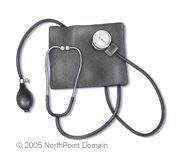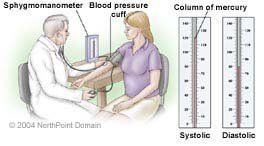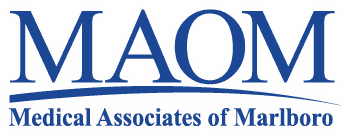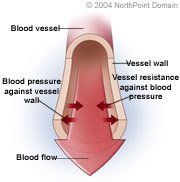Hypertension
Basic Facts
- Hypertension is high blood pressure that persists over time.
- More Americans visit their physician for the management of hypertension than for any other disease-specific reason.
- Compared to people with normal blood pressure, people with hypertension are 3 times more likely to develop coronary heart disease, 6 times more likely to develop congestive heart failure, and 7 times more likely to have a stroke.

A blood pressure reading uses two numbers that represent the two phases of the heartbeat. The systolic reading corresponds to blood pressure when the heart contracts; the diastolic reading corresponds to blood pressure when the heart relaxes. Normal blood pressure is less than 120 millimeters of mercury (mm Hg) systolic and less than 80 mm Hg diastolic, expressed as 120 over 80 (for example 120/80). A person has hypertension if his or her blood pressure is consistently 140 over 90 mm Hg or higher. Prehypertension is defined as blood pressure between 120 and 139 systolic and 80 and 89 diastolic.
Hypertension can accelerate atherosclerosis, or hardening of arteries, because arteries that carry blood under high pressures thicken, and arteries thickened from hypertension are more susceptible to atherosclerosis. Because hypertension affects the arterial system in this way, it can contribute to various conditions, including:
- Heart attack;
- Stroke;
- Kidney failure;
- Coronary heart disease;
- Congestive heart failure;
- Cardiomyopathy;
- Angina pectoris; and
- Blurred vision and blindness.
WHAT ARE THE SYMPTOMS?
Most people with hypertension initially have no symptoms. When symptoms occur, they can include:
- Headache;
- Nosebleeds;
- Fatigue;
- Dizziness; and
- Flushed face.
- Nausea;
- Irregular or rapid heartbeat;
- Vomiting;
- Shortness of breath;
- Blurred vision; and
- A buzzing noise inside the head.
CAUSES AND RISK FACTORS
Most often, when the cause of hypertension is unknown, it is called primary, or essential, hypertension. Secondary hypertension is high blood pressure caused by another condition (such as kidney problems, adrenal gland disorders, narrowing of the aorta, or pregnancy). Some potential causes of primary hypertension include:
- Narrowed arteries;
- Excessive blood volume; and
- An abnormally faster or forceful heartbeat.
Several risk factors influence the development of hypertension, including:
- Age (The risk of developing hypertension increases after age 35; 65 percent of people older than 60 have hypertension.);
- Heredity;
- Race (African Americans are more likely to develop hypertension than Caucasians.);
- Gender (Until age 55, men are more likely to develop hypertension than women. Women become more likely to develop hypertension with age, however.);
- Smoking;
- Being overweight;
- Alcohol;
- Sedentary lifestyle; and
- Medications.
DIAGNOSIS
Blood pressure normally fluctuates. Therefore, hypertension is only diagnosed if blood pressure is consistently high over time.
A physician measures blood pressure using a device called a sphygmomanometer, which is attached to an armband-like cuff that is wrapped snugly around the upper arm. The cuff is inflated so that it momentarily blocks blood flow. The physician then slowly releases the air from the cuff, resuming blood flow, and listens to the sounds of blood flowing to the artery while watching the dial on the sphygmomanometer. The position of the dial during the first audible thump is the systolic pressure, while the position when the thumping becomes inaudible is the diastolic pressure.
Some people experience high blood pressure related to anxiety and nervousness caused by a visit to a doctor's office, called white-coat syndrome. Patients who experience this can use mobile blood pressure monitors away from the doctor's office to accurately measure their blood pressure.

TREATMENT APPROACH
Primary hypertension can be controlled, but not cured. Secondary hypertension can be cured by treating the underlying condition. Because a person's diet and exercise habits can affect blood pressure, physicians first recommend making lifestyle changes, including:
- Stopping smoking;
- Losing weight;
- Limiting alcohol consumption to 1 to 2 drinks per day;
- Exercising; and
- Eating a low-sodium diet.
Physicians commonly prescribe medications in addition to recommending lifestyle changes, or if lifestyle changes do not control hypertension. Medications called antihypertensives are commonly prescribed to control hypertension including:
- Centrally acting agents (affect brain chemistry);
- Peripherally acting agents (act on the nerves that regulate blood pressure);
- Direct-acting vasodilators (relax blood vessel walls);
- Beta-blockers;
- Calcium channel blockers;
- Diuretics; and
- Angiotensin drugs.
Copyright © 2017 NorthPoint Domain, Inc. All rights reserved.
This material cannot be reproduced in digital or printed form without the express consent of NorthPoint Domain, Inc. Unauthorized copying or distribution of NorthPoint Domain's Content is an infringement of the copyright holder's rights.

